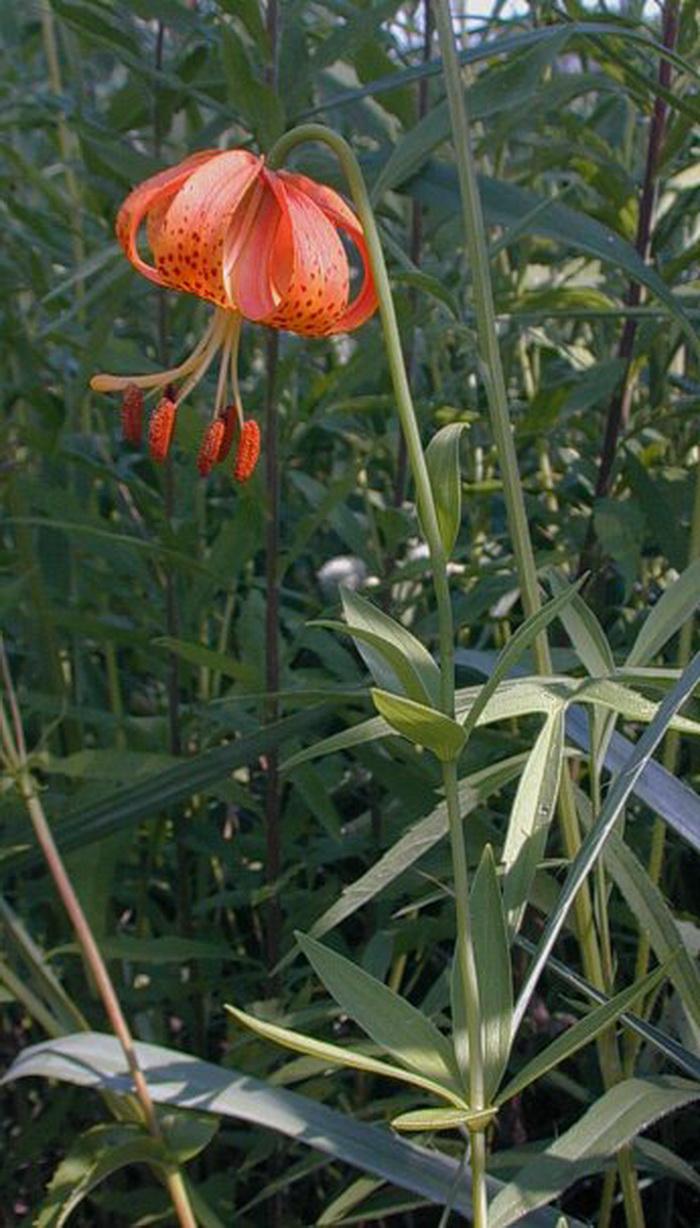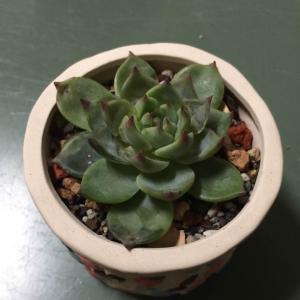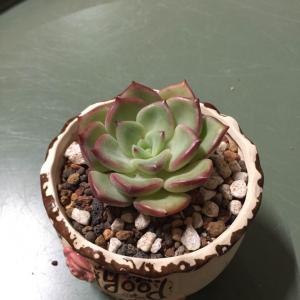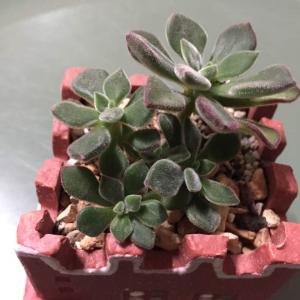文章
Miss Chen
2018年01月19日

Description: This perennial plant is 1½–4' tall, more or less erect, and unbranched. The central stem is light to medium green, terete, glabrous, and sometimes glaucous. The leaves usually occur in whorls of 3-7 along the stem, although some of the upper leaves may occur in pairs or they may alternate individually. Individual leaves are 2½–5" long and ¼–¾" across; they are elliptic in shape, smooth (entire) along their margins, and sessile or nearly so. Leaf venation is parallel. The upper leaf surface is medium green and glabrous, while the lower leaf surface is light-medium or whitish green, glabrous, and sometimes glaucous. Above the terminal leaves of the central stem, there are 1-6 nodding flowers on stalks about 4-8" long (one flower per stalk). These stalks are erect or ascending; they are light to medium green, terete, glabrous, and sometimes glaucous. Each showy flower is about 2-3" long and similarly across, consisting of 6 tepals, 6 stamens, and a pistil with a single style. The tepals are yellow-orange to orange-red, purple-spotted, lanceolate in shape, and strongly recurved; the tips of the tepals are located near the base of the flower. The stamens are strongly exserted and slightly spreading; their filaments are light green to nearly white, while their anthers are reddish brown, oblongoid or ellipsoid in shape, and less than ½" in length. The style is strongly exserted and curved slightly upward; it is light yellow to nearly white, except toward the slightly swollen tip, where it is tinted yellow to orange-red.
The blooming period occurs from early to mid-summer, lasting about 1 month. There is no noticeable floral scent. Afterwards, the flowers are replaced by seedpods. These seedpods are about 1½" long, oblongoid in shape, 3-celled, and glabrous; they split open into 3 parts to release their seeds. Mature seeds are brown, flattened, ovate-deltate in shape, and strongly winged along their margins. The thin papery wings enable the seeds to be carried some distance by gusts of wind. The root system consists of a yellow bulb with fibrous roots below, from which clonal offsets with new bulbs may form.
Cultivation: The preference is full to partial sun, loamy soil or sandy loam, and moist conditions. An established plant, however, can withstand some drought. Cultivation from seed is slow and difficult, while cultivation from bulbs or transplants is somewhat faster and easier. Plants that are spoiled with too much fertilizer and watering may flop over.
Range & Habitat: The native Michigan Lily occurs in scattered counties of Illinois (see Distribution Map), where it is uncommon. Habitats include moist black soil prairies, openings in deciduous woodlands, typical thickets and sandy thickets, Bur Oak savannas, moist sandy meadows along rivers, swamps, fens, and prairie remnants along railroads. Michigan Lily is found in higher quality natural areas.

Faunal Associations: Cross-pollination is required for fertile seeds. The large showy flowers appear to be designed to attract hummingbirds and larger day-flying insects, such as Sphinx moths, Hummingbird moths (Hemaris spp.), and the larger butterflies. Robertson (1929) observed such butterflies as the Monarch (Danaus plexippus), Great Spangled Fritillary (Speyeria cybele), and Spicebush Swallowtail (Papilio troilus) visiting the flowers for nectar. Other insects feed destructively on lilies (Lilium spp.). These species include the Lily Leaf Beetle (Lilioceris lilii), stem-boring larvae of the Burdock Borer Moth (Papaipema cataphracta), stem-boring larvae of the Golden Borer Moth (Papaipema cerina), larvae of the Narcissus Bulb Fly (Merodon equestris), the Crescent-marked Lily Aphid (Aulacorthum circumflexum), and the Tulip Bulb Aphid (Dysaphis tulipae); see Marshall (2006), Covell (1984/2005), Panzer et al. (2006), Cranshaw (2004), and Blackman & Eastop (2013). Deer, rabbits, horses, cattle, and other livestock occasionally browse on the foliage, while voles sometimes eat the bulbs.
Photographic Location: The photographs were taken at Meadowbrook Park in Urbana, Illinois, and a wildflower garden at the Anita Purves Nature Center of the same city.

Comments: This is an attractive plant that can be cultivated in flower gardens. For many years, the Michigan Lily (Lilium michiganense) was not distinguished from the Turk's Cap Lily (Lilium superbum), even though there are several characteristics that can be used to distinguish them, including the following: 1) the Michigan Lily has a more northern distribution in Illinois than the latter, 2) the anthers of Michigan Lily are less than ½" in length, while the anthers of the latter species are ½" or longer and they are more slender in shape, 3) the tepals of Michigan Lily curve backward so that their tips are located near the base of the flower, while the tepals of Turk's Cap Lily curve backward so that their tips are located behind the base of the flower, 4) the Michigan Lily usually has yellow bulbs, while the latter lily usually has white bulbs, 5) Turk's Cap Lily sometimes has a 6-pointed green star on the throats of its flowers, while the flowers of Michigan Lily never have this characteristic, and 6) the Turk Cap's Lily is usually taller and it blooms less reliably than the Michigan Lily, at least in Illinois.
The blooming period occurs from early to mid-summer, lasting about 1 month. There is no noticeable floral scent. Afterwards, the flowers are replaced by seedpods. These seedpods are about 1½" long, oblongoid in shape, 3-celled, and glabrous; they split open into 3 parts to release their seeds. Mature seeds are brown, flattened, ovate-deltate in shape, and strongly winged along their margins. The thin papery wings enable the seeds to be carried some distance by gusts of wind. The root system consists of a yellow bulb with fibrous roots below, from which clonal offsets with new bulbs may form.
Cultivation: The preference is full to partial sun, loamy soil or sandy loam, and moist conditions. An established plant, however, can withstand some drought. Cultivation from seed is slow and difficult, while cultivation from bulbs or transplants is somewhat faster and easier. Plants that are spoiled with too much fertilizer and watering may flop over.
Range & Habitat: The native Michigan Lily occurs in scattered counties of Illinois (see Distribution Map), where it is uncommon. Habitats include moist black soil prairies, openings in deciduous woodlands, typical thickets and sandy thickets, Bur Oak savannas, moist sandy meadows along rivers, swamps, fens, and prairie remnants along railroads. Michigan Lily is found in higher quality natural areas.

Faunal Associations: Cross-pollination is required for fertile seeds. The large showy flowers appear to be designed to attract hummingbirds and larger day-flying insects, such as Sphinx moths, Hummingbird moths (Hemaris spp.), and the larger butterflies. Robertson (1929) observed such butterflies as the Monarch (Danaus plexippus), Great Spangled Fritillary (Speyeria cybele), and Spicebush Swallowtail (Papilio troilus) visiting the flowers for nectar. Other insects feed destructively on lilies (Lilium spp.). These species include the Lily Leaf Beetle (Lilioceris lilii), stem-boring larvae of the Burdock Borer Moth (Papaipema cataphracta), stem-boring larvae of the Golden Borer Moth (Papaipema cerina), larvae of the Narcissus Bulb Fly (Merodon equestris), the Crescent-marked Lily Aphid (Aulacorthum circumflexum), and the Tulip Bulb Aphid (Dysaphis tulipae); see Marshall (2006), Covell (1984/2005), Panzer et al. (2006), Cranshaw (2004), and Blackman & Eastop (2013). Deer, rabbits, horses, cattle, and other livestock occasionally browse on the foliage, while voles sometimes eat the bulbs.
Photographic Location: The photographs were taken at Meadowbrook Park in Urbana, Illinois, and a wildflower garden at the Anita Purves Nature Center of the same city.

Comments: This is an attractive plant that can be cultivated in flower gardens. For many years, the Michigan Lily (Lilium michiganense) was not distinguished from the Turk's Cap Lily (Lilium superbum), even though there are several characteristics that can be used to distinguish them, including the following: 1) the Michigan Lily has a more northern distribution in Illinois than the latter, 2) the anthers of Michigan Lily are less than ½" in length, while the anthers of the latter species are ½" or longer and they are more slender in shape, 3) the tepals of Michigan Lily curve backward so that their tips are located near the base of the flower, while the tepals of Turk's Cap Lily curve backward so that their tips are located behind the base of the flower, 4) the Michigan Lily usually has yellow bulbs, while the latter lily usually has white bulbs, 5) Turk's Cap Lily sometimes has a 6-pointed green star on the throats of its flowers, while the flowers of Michigan Lily never have this characteristic, and 6) the Turk Cap's Lily is usually taller and it blooms less reliably than the Michigan Lily, at least in Illinois.
1
0
文章
Miss Chen
2018年01月19日

Description: This perennial wildflower is 1–2½' tall and unbranched. The central stem is light green, slightly ridged, and glabrous to hairy. The alternate leaves occur along the entire length of the stem in widely spreading pseudo-whorls. The lowest leaves are 4-6" long and about ¼" across, becoming gradually smaller as they ascend the stem. The leaves are medium green, linear in shape, sessile, and glabrous to short-pubescent. Each stem terminates in a spike or narrow raceme of flowerheads about 2-8" long. These flowerheads are relatively few in number, and on rare occasions only a single flowerhead may be produced. Each flat-topped flowerhead is about ½–1" across, consisting of 15-45 pink disk florets above and overlapping floral bracts (phyllaries) below. There are no ray florets. Individual disk florets are tubular in shape; each of these florets has 5 recurved slender lobes at its apex. Each disk floret has a bifurcated style that is white to light pink; it is often strongly exerted and recurved.

The scaly bracts are green, glabrous to hairy, and relatively large in size; they are either straight and loosely arranged around the base of each flowerhead, or they are strongly recurved. The bracts are lanceolate, broadly lanceolate, or deltoid in shape and their tips are pointed, rather than rounded. The flowerheads are either sessile (or nearly so), or they can have peduncles up to 1¼" long. At the base of each peduncle (or sessile flowerhead), there is a small leafy bract that is linear in shape. The blooming period occurs from mid- to late summer and lasts about 1 month. The flowerheads bloom from the top to the bottom. With maturation, the disk florets are replaced by small achenes that are bullet-shaped and pubescent; each achene has a tuft of feathery bristles at its apex. The achenes are distributed by the wind to some extent. The root system consists of a globoid corm with fibrous roots below. Sometimes vegetative offsets are produced.
Cultivation: The preference is full sun, dry-mesic to dry conditions, and a barren soil containing rocky material or some sand.
Central Stem & Leaves
Range & Habitat: The native Scaly Blazingstar is occasional in southern Illinois and absent elsewhere in the state (see Distribution Map). Habitats include hill prairies, limestone or sandstone glades, ledges of sunny cliffs, openings in upland rocky woodlands, and barren savannas. This wildflower is found in high quality natural areas. Occasional wildfires are beneficial because the encroachment of woody vegetation is reduced.
Faunal Assocations: The flowerheads are cross-pollinated primarily by bumblebees, butterflies, and skippers. In general, several insect species feed on Liatris spp. (Blazingstars). These species include: the caterpillars of Schinia sanguinea (Blazingstar Flower Moth), which feed on the florets and developing seeds; the caterpillars of Papaipema beeriana (Blazingstar Borer Moth) and Carmenta anthracipennis (Liatris Borer Moth), which bore through the stems; and the aphids Aphis laciniariae and Aphis craccivora, which suck plant juices. The foliage and flowerheads of Blazingstars are edible to many mammalian herbivores, including cattle, horses, sheep, goats, deer, rabbits, and groundhogs. Where these mammals are abundant, Blazingstar populations usually decline.
Photographic Location: The wildflower garden of the webmaster in Urbana, Illinois.
Comments: Scaly Blazingstar is highly variable across its range and several varieties have been described. Generally, all of these varieties have relatively large floral bracts with pointed tips that are either loosely arranged or recurved along the bottoms of the flowerheads. However, there is considerable variability in the following characteristics: 1) the size of individual flowerheads can be variable with 15-45 (or more) disk florets, 2) the flowerheads can be sessile or they can have short to medium-length peduncles, 3) the leaves and stems can be glabrous to hairy, and 4) the floral bracts that define the base of each flowerhead can be either straight or strongly recurved. Scaly Blazingstar differs from other Liatris spp. (Blazingstars) primarily by the characteristics of its scaly floral bracts, which provide it with a rather odd appearance.

The scaly bracts are green, glabrous to hairy, and relatively large in size; they are either straight and loosely arranged around the base of each flowerhead, or they are strongly recurved. The bracts are lanceolate, broadly lanceolate, or deltoid in shape and their tips are pointed, rather than rounded. The flowerheads are either sessile (or nearly so), or they can have peduncles up to 1¼" long. At the base of each peduncle (or sessile flowerhead), there is a small leafy bract that is linear in shape. The blooming period occurs from mid- to late summer and lasts about 1 month. The flowerheads bloom from the top to the bottom. With maturation, the disk florets are replaced by small achenes that are bullet-shaped and pubescent; each achene has a tuft of feathery bristles at its apex. The achenes are distributed by the wind to some extent. The root system consists of a globoid corm with fibrous roots below. Sometimes vegetative offsets are produced.
Cultivation: The preference is full sun, dry-mesic to dry conditions, and a barren soil containing rocky material or some sand.
Central Stem & Leaves
Range & Habitat: The native Scaly Blazingstar is occasional in southern Illinois and absent elsewhere in the state (see Distribution Map). Habitats include hill prairies, limestone or sandstone glades, ledges of sunny cliffs, openings in upland rocky woodlands, and barren savannas. This wildflower is found in high quality natural areas. Occasional wildfires are beneficial because the encroachment of woody vegetation is reduced.
Faunal Assocations: The flowerheads are cross-pollinated primarily by bumblebees, butterflies, and skippers. In general, several insect species feed on Liatris spp. (Blazingstars). These species include: the caterpillars of Schinia sanguinea (Blazingstar Flower Moth), which feed on the florets and developing seeds; the caterpillars of Papaipema beeriana (Blazingstar Borer Moth) and Carmenta anthracipennis (Liatris Borer Moth), which bore through the stems; and the aphids Aphis laciniariae and Aphis craccivora, which suck plant juices. The foliage and flowerheads of Blazingstars are edible to many mammalian herbivores, including cattle, horses, sheep, goats, deer, rabbits, and groundhogs. Where these mammals are abundant, Blazingstar populations usually decline.
Photographic Location: The wildflower garden of the webmaster in Urbana, Illinois.
Comments: Scaly Blazingstar is highly variable across its range and several varieties have been described. Generally, all of these varieties have relatively large floral bracts with pointed tips that are either loosely arranged or recurved along the bottoms of the flowerheads. However, there is considerable variability in the following characteristics: 1) the size of individual flowerheads can be variable with 15-45 (or more) disk florets, 2) the flowerheads can be sessile or they can have short to medium-length peduncles, 3) the leaves and stems can be glabrous to hairy, and 4) the floral bracts that define the base of each flowerhead can be either straight or strongly recurved. Scaly Blazingstar differs from other Liatris spp. (Blazingstars) primarily by the characteristics of its scaly floral bracts, which provide it with a rather odd appearance.
0
0
文章
Miss Chen
2018年01月19日

Description: This herbaceous perennial plant is 1–1½' tall and unbranched. The central stem is largely hairless, except for a few hairs near the inflorescence. The leaves are up to 8" long and 1/3" (8 mm.) across, becoming smaller and fewer as they ascend the stem. These leaves appear whorled because of their density, but they actually alternate around the stem.

They are linear, sessile, and hairless, while their margins are smooth. A short spike-like raceme of compound flowers about 2-4" long occurs at the top of the stem. They are pink or purplish pink, and quite showy. A compound flower consists of about 15-25 tubular flowers that are crowded together into a head spanning about 1" across. Each flower has 5 small lobes that curl outward, while a divided style protrudes from the center. This style is white or pinkish white, and rather long and curly. Each compound flower is subtended by green bracts that form a smooth, cylindrical surface about 1½" long. The blooming period is mid- to late summer, and lasts about a month. There is no floral scent. The achenes later develop bristly hairs that aid in their dispersal. The root system consists of a corm, which may occasionally produce offsets.
Cultivation: The preference is full sun, poor soil, and dry conditions. This plant often grows on hills or slopes amid rocky material, but it also tolerates loamy soil if the site is well-drained. Drought tolerance is excellent, and foliar disease is not a significant problem at most locations. This plant doesn't compete well against taller, more aggressive plants on fertile soil where there is level ground.

Range & Habitat: The native Cylindrical Blazingstar is a fairly uncommon plant that occurs primarily in northern and western Illinois (see Distribution Map). It is rare or absent in other areas. Habitats include dry upland areas of black soil prairies, hill prairies, openings in rocky upland woods, oak savannas, limestone glades, rocky bluffs and cliffs along major rivers, moist sand flats near Lake Michigan, and shoulders of highways. This plant is typically found in marginal areas that are little disturbed by modern development.
Faunal Associations: The flowers are visited primarily by long-tongued bees, butterflies, skippers, and bee flies. Some short-tongued bees may visit the flowers to collect pollen, but they are not effective pollinators. The caterpillars of the rare Schinia gloriosa (Glorious Flower Moth) feed on the flowers and seed capsules of this and other Liatris spp. Mammalian herbivores readily consume all parts of this plant, including rabbits, groundhogs, deer, and livestock. Prairie and Meadow Voles sometimes eat the corms. An overpopulation of these animals can make the establishment of this plant difficult in some areas.
Photographic Location: The photographs were taken at a wildflower garden near the Red Bison Railroad Prairie in Champaign, Illinois.
Comments: This is another lovely Blazingstar; it is much shorter than most of the others, and tends to bloom earlier. Cylindrical Blazingstar is easy to identify because of the smooth cylindrical surface formed by the green bracts subtending the flowers; this cylindrical surface is longer and larger than what is encountered in other Blazingstars that occur in Illinois. Amerindians would sometimes eat the corms of Blazingstars, although this was considered starvation food.

They are linear, sessile, and hairless, while their margins are smooth. A short spike-like raceme of compound flowers about 2-4" long occurs at the top of the stem. They are pink or purplish pink, and quite showy. A compound flower consists of about 15-25 tubular flowers that are crowded together into a head spanning about 1" across. Each flower has 5 small lobes that curl outward, while a divided style protrudes from the center. This style is white or pinkish white, and rather long and curly. Each compound flower is subtended by green bracts that form a smooth, cylindrical surface about 1½" long. The blooming period is mid- to late summer, and lasts about a month. There is no floral scent. The achenes later develop bristly hairs that aid in their dispersal. The root system consists of a corm, which may occasionally produce offsets.
Cultivation: The preference is full sun, poor soil, and dry conditions. This plant often grows on hills or slopes amid rocky material, but it also tolerates loamy soil if the site is well-drained. Drought tolerance is excellent, and foliar disease is not a significant problem at most locations. This plant doesn't compete well against taller, more aggressive plants on fertile soil where there is level ground.

Range & Habitat: The native Cylindrical Blazingstar is a fairly uncommon plant that occurs primarily in northern and western Illinois (see Distribution Map). It is rare or absent in other areas. Habitats include dry upland areas of black soil prairies, hill prairies, openings in rocky upland woods, oak savannas, limestone glades, rocky bluffs and cliffs along major rivers, moist sand flats near Lake Michigan, and shoulders of highways. This plant is typically found in marginal areas that are little disturbed by modern development.
Faunal Associations: The flowers are visited primarily by long-tongued bees, butterflies, skippers, and bee flies. Some short-tongued bees may visit the flowers to collect pollen, but they are not effective pollinators. The caterpillars of the rare Schinia gloriosa (Glorious Flower Moth) feed on the flowers and seed capsules of this and other Liatris spp. Mammalian herbivores readily consume all parts of this plant, including rabbits, groundhogs, deer, and livestock. Prairie and Meadow Voles sometimes eat the corms. An overpopulation of these animals can make the establishment of this plant difficult in some areas.
Photographic Location: The photographs were taken at a wildflower garden near the Red Bison Railroad Prairie in Champaign, Illinois.
Comments: This is another lovely Blazingstar; it is much shorter than most of the others, and tends to bloom earlier. Cylindrical Blazingstar is easy to identify because of the smooth cylindrical surface formed by the green bracts subtending the flowers; this cylindrical surface is longer and larger than what is encountered in other Blazingstars that occur in Illinois. Amerindians would sometimes eat the corms of Blazingstars, although this was considered starvation food.
0
0
文章
Miss Chen
2018年01月19日

Description: This perennial plant is 2-5' and unbranched. The central stem is green or dark red, and it has short stiff hairs. The leaves toward the base are up to 12" long and 1" wide, becoming progessively shorter and narrower as they alternate up the stalk. The leaves are sufficiently crowded together that they appear whorled. They are narrowly lanceolate or linear, dull green or bluish green, and usually slightly pubescent. The margins are smooth or slightly ciliate.
The central stem terminates in an erect spike-like inflorescence with pink or purplish pink composite flowers. This inflorescence is about ½–1½' long, with the composite flowers more or less densely distributed along its length. The individual flowers are crowded together into buttons about 1" across. Each flower has 5 lobes that spread outward from the corolla tube, from which emerges a long divided style that is often curly. There is no floral scent. The blooming period occurs from late summer to early fall and lasts about 3 weeks for individual plants. Like other Liatris spp., the flowers of Rough Blazingstar begin to bloom at the top of the flowering stalk, and gradually bloom downward as the season progresses. The achenes have large tufts of stiff hair that are light greyish brown, which enables them to be distributed several feet by the wind. The root system consists of a woody corm. Occasionally, offsets develop a short distance from the mother plant, creating small colonies.

Cultivation: The preference is full sun and mesic to dry conditions. The soil can contain significant amounts of loam, clay, sand, or rocky material. However, this plant typically grows in less fertile acidic soil that is rather rocky or sandy. This plant is easy to grow under well-drained conditions, but has a tendency to flop over while in flower if it is spoiled with rich soil or too much moisture. Foliar disease is rarely a problem, and drought resistant is very good, with only a few lower leaves withering away.
Range & Habitat: The native Rough Blazingstar is occasional in central and northern Illinois, but it is uncommon or absent in SE Illinois (see Distribution Map). This wildflower is widely distributed, but rarely forms large colonies in native habitats, unlike Liatris pychnostachya (Prairie Blazingstar). Habitats include mesic to dry black soil prairies, sand prairies, gravel prairies, hill prairies, bald knobs, openings in rocky upland forests, sandy Black Oak woodlands, savannas, limestone glades, dry clay banks above ditches, and open areas along railroads, particularly where prairie remnants occur.

Faunal Associations: Primarily long-tongued bees, butterflies, skippers, and bee flies visit the flowers. Among the long-tongued bees, this includes honeybees, bumblebees, Little Carpenter bees, Miner bees, and Leaf-Cutting bees. Butterfly visitors include Monarchs, Painted Ladies, Black Swallowtails, Sulfurs, and others. Other visitors include Green Metallic bees and other Halictine bees. The latter bees collect pollen primarily, and are not effective pollinators. The caterpillars of the rare Schinia florida (Glorious Flower Moth) feed on the flowers and seed capsules of this and other Liatris spp. Mammmalian herbivores, large and small, readily eat the foliage and stems, including rabbits, deer, groundhogs, and livestock. Sometimes small rodents will dig up the corms and eat them. Consequently, this plant may be scarce where there is an overpopulation of these animals.

Photographic Location: The photographs were taken at Red Bison Railroad Prairie in Savoy, Illinois, Meadowbrook Park in Urbana, Illinois, and the wildflower garden of the webmaster.
Comments: This is a beautiful plant while it is flowering, although the blooming period is rather short. It is possible to extend the season of bloom by planting other Liatris spp, which usually bloom earlier in the year. Among the taller blazingstars, this species prefers drier locations, and can be distinguished from them by the large size of its buttons of flowers. The corms were used as an emergency survival food among some tribes of Amerindians.
The central stem terminates in an erect spike-like inflorescence with pink or purplish pink composite flowers. This inflorescence is about ½–1½' long, with the composite flowers more or less densely distributed along its length. The individual flowers are crowded together into buttons about 1" across. Each flower has 5 lobes that spread outward from the corolla tube, from which emerges a long divided style that is often curly. There is no floral scent. The blooming period occurs from late summer to early fall and lasts about 3 weeks for individual plants. Like other Liatris spp., the flowers of Rough Blazingstar begin to bloom at the top of the flowering stalk, and gradually bloom downward as the season progresses. The achenes have large tufts of stiff hair that are light greyish brown, which enables them to be distributed several feet by the wind. The root system consists of a woody corm. Occasionally, offsets develop a short distance from the mother plant, creating small colonies.

Cultivation: The preference is full sun and mesic to dry conditions. The soil can contain significant amounts of loam, clay, sand, or rocky material. However, this plant typically grows in less fertile acidic soil that is rather rocky or sandy. This plant is easy to grow under well-drained conditions, but has a tendency to flop over while in flower if it is spoiled with rich soil or too much moisture. Foliar disease is rarely a problem, and drought resistant is very good, with only a few lower leaves withering away.
Range & Habitat: The native Rough Blazingstar is occasional in central and northern Illinois, but it is uncommon or absent in SE Illinois (see Distribution Map). This wildflower is widely distributed, but rarely forms large colonies in native habitats, unlike Liatris pychnostachya (Prairie Blazingstar). Habitats include mesic to dry black soil prairies, sand prairies, gravel prairies, hill prairies, bald knobs, openings in rocky upland forests, sandy Black Oak woodlands, savannas, limestone glades, dry clay banks above ditches, and open areas along railroads, particularly where prairie remnants occur.

Faunal Associations: Primarily long-tongued bees, butterflies, skippers, and bee flies visit the flowers. Among the long-tongued bees, this includes honeybees, bumblebees, Little Carpenter bees, Miner bees, and Leaf-Cutting bees. Butterfly visitors include Monarchs, Painted Ladies, Black Swallowtails, Sulfurs, and others. Other visitors include Green Metallic bees and other Halictine bees. The latter bees collect pollen primarily, and are not effective pollinators. The caterpillars of the rare Schinia florida (Glorious Flower Moth) feed on the flowers and seed capsules of this and other Liatris spp. Mammmalian herbivores, large and small, readily eat the foliage and stems, including rabbits, deer, groundhogs, and livestock. Sometimes small rodents will dig up the corms and eat them. Consequently, this plant may be scarce where there is an overpopulation of these animals.

Photographic Location: The photographs were taken at Red Bison Railroad Prairie in Savoy, Illinois, Meadowbrook Park in Urbana, Illinois, and the wildflower garden of the webmaster.
Comments: This is a beautiful plant while it is flowering, although the blooming period is rather short. It is possible to extend the season of bloom by planting other Liatris spp, which usually bloom earlier in the year. Among the taller blazingstars, this species prefers drier locations, and can be distinguished from them by the large size of its buttons of flowers. The corms were used as an emergency survival food among some tribes of Amerindians.
0
0


















